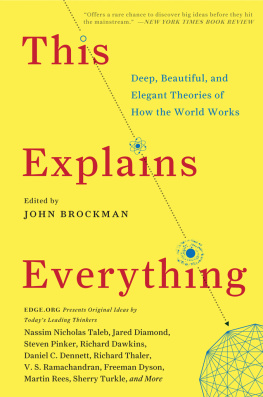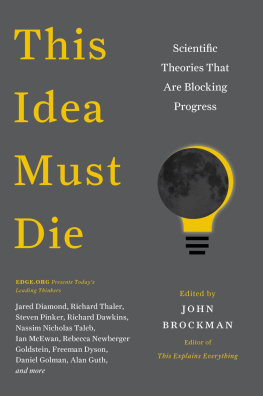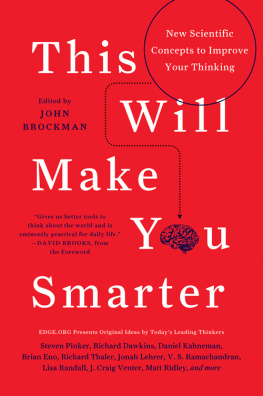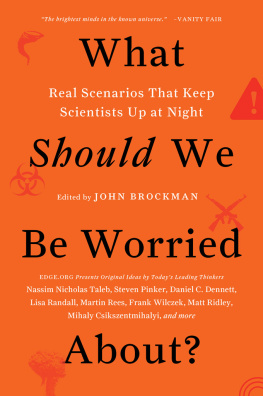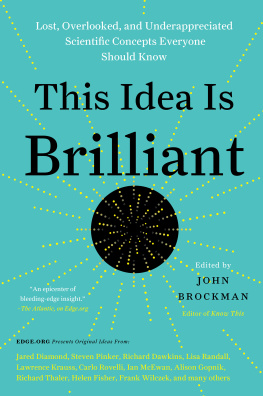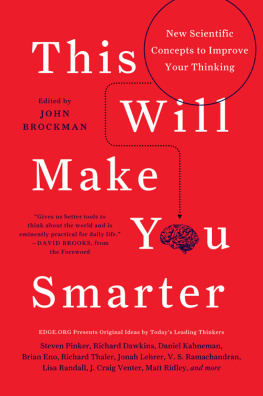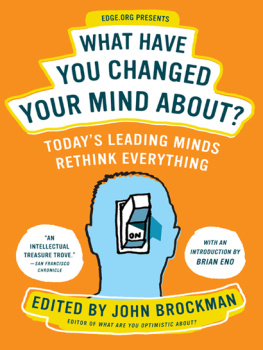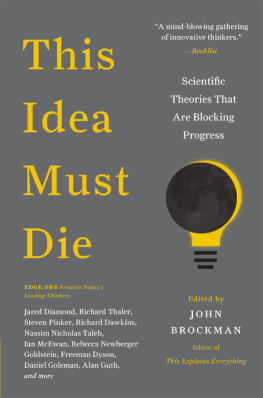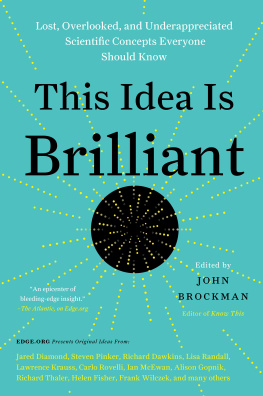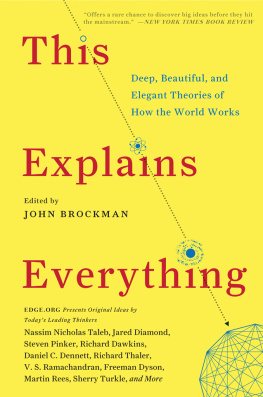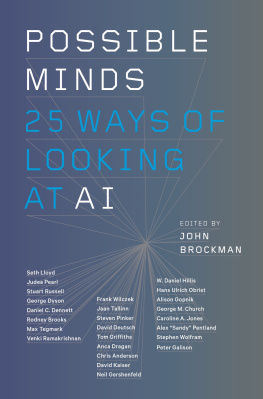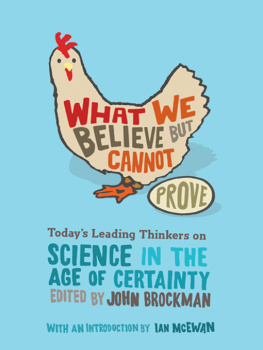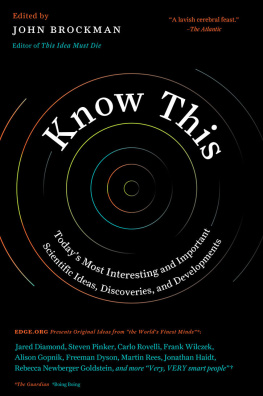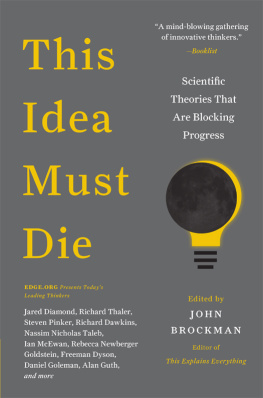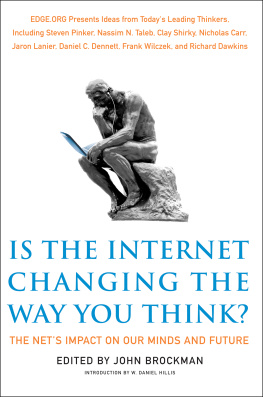
This Explains Everything
Deep, Beautiful, and Elegant Theories of How the World Works
Edited by
JOHN BROCKMAN

CONTENTS
SUSAN BLACKMORE
MATT RIDLEY
RICHARD DAWKINS
SCOTT ATRAN
CARLO ROVELLI
AUBREY DE GREY
LEONARD SUSSKIND
JOEL GOLD
ALAN ALDA
REBECCA NEWBERGER GOLDSTEIN
JAMES J. ODONNELL
PAUL STEINHARDT
SHING-TUNG YAU
FRANK WILCZEK
THOMAS METZINGER
SEAN CARROLL
STEVEN PINKER
JONATHAN GOTTSCHALL
DAVID G. MYERS
ARMAND MARIE LEROI
GERD GIGERENZER
MARTIN J. REES
ANTON ZEILINGER
JEREMY BERNSTEIN
ANDREI LINDE
GEORGE DYSON
MAX TEGMARK
GINO SEGR
FREEMAN DYSON
SATYAJIT DAS
HAIM HARARI
ROBERT PROVINE
V. S. RAMACHANDRAN
DAVID M. EAGLEMAN
MAHZARIN BANAJI
ROBERT SAPOLSKY
KEITH DEVLIN
RICHARD H. THALER
JENNIFER JACQUET
JUDITH RICH HARRIS
DAN SPERBER
CLAY SHIRKY
HUGO MERCIER
NICHOLAS HUMPHREY
STEWART BRAND
KEVIN P. HAND
PAUL SAFFO
DANIEL C. DENNETT
CARL ZIMMER
DAVID M. BUSS
DAVID PIZARRO
HOWARD GARDNER
ANDRIAN KREYE
RAPHAEL BOUSSO
ERIC R. WEINSTEIN
DAVE WINER
TANIA LOMBROZO
SEIRIAN SUMNER
HELENA CRONIN
PAUL BLOOM
JOHN McWHORTER
GREGORY COCHRAN
CHRISTINE FINN
ANDREW LIH
PZ MYERS
DAVID CHRISTIAN
DIMITAR D. SASSELOV
HELEN FISHER
JOHN NAUGHTON
BARRY C. SMITH
JOHN TOOBY
PETER ATKINS
ELIZABETH DUNN
BART KOSKO
CHARLES SIMONYI
GREGORY S. PAUL
BRUCE HOOD
A. C. GRAYLING
TIMO HANNAY
BRIAN ENO
LISA RANDALL
SIMONE SCHNALL
BENJAMIN K. BERGEN
JON KLEINBERG
MARTI HEARST
HANS-ULRICH OBRIST
SETH LLOYD
CHARLES SEIFE
RODNEY A. BROOKS
JOHN C. MATHER
SCOTT SAMPSON
LAURENCE C. SMITH
TIM OREILLY
S. ABBAS RAZA
EVGENY MOROZOV
ERNST PPPEL
BRUCE PARKER
PATRICK BATESON
SIMON BARON-COHEN
ALVY RAY SMITH
ALBERT-LSZL BARABSI
STUART PIMM
KARL SABBAGH
ADAM ALTER
GERALD SMALLBERG
DOUGLAS COUPLAND
KATINKA MATSON
ALUN ANDERSON
ERIC R. KANDEL
SHERRY TURKLE
RANDOLPH NESSE
MARCEL KINSBOURNE
NICHOLAS A. CHRISTAKIS
PHILIP CAMPBELL
DYLAN EVANS
DOUGLAS RUSHKOFF
PHILIP ZIMBARDO
ALISON GOPNIK
STEPHEN M. KOSSLYN AND ROBIN ROSENBERG
TERRENCE J. SEJNOWSKI
MICHAEL I. NORTON
LAWRENCE M. KRAUSS
NEIL GERSHENFELD
LEE SMOLIN
ERIC J. TOPOL
GERALD HOLTON
NASSIM NICHOLAS TALEB
ROBERT KURZBAN
TIMOTHY D. WILSON
SAMUEL BARONDES
BEATRICE GOLOMB
EMANUEL DERMAN
DAVID GELERNTER
RUDY RUCKER
SAMUEL ARBESMAN
STANISLAS DEHAENE
MIHALY CSIKSZENTMIHALYI
VICTORIA STODDEN
GEORGE CHURCH
IRENE PEPPERBERG
GLORIA ORIGGI
RICHARD FOREMAN
JARED DIAMOND
TIMOTHY TAYLOR
ANDY CLARK
NICHOLAS J. CARR
MICHAEL SHERMER
KEVIN KELLY
THE EDGE QUESTION
In 1981, I founded the Reality Club. From its founding through 1996, the club held its meetings in Chinese restaurants, artists lofts, the boardrooms of investment-banking firms, ballrooms, museums, and living rooms, among other venues. The Reality Club differed from the Algonquin Round Table, the Apostles, and the Bloomsbury Group, but it offered the same quality of intellectual adventure. Perhaps the closest resemblance was to the late 18th- and early 19th-century Lunar Society of Birmingham, an informal gathering of the leading cultural figures of the new industrial ageJames Watt, Erasmus Darwin, Josiah Wedgwood, Joseph Priestley, Benjamin Franklin. In a similar fashion, the Reality Club was an attempt to gather together those people exploring the themes of the postIndustrial Age.
In 1997, the Reality Club went online, rebranded as Edge . The ideas presented on Edge are speculative; they represent the frontiers in such areas as evolutionary biology, genetics, computer science, neurophysiology, psychology, cosmology, and physics. Emerging out of these contributions is a new natural philosophy, new ways of understanding physical systems, new ways of thinking that call into question many of our basic assumptions.
For each of the anniversary editions of Edge , I and a number of Edge stalwarts, including Stewart Brand, Kevin Kelly, and George Dyson, get together to plan the annual Edge Questionusually one that comes to one or another of us or our correspondents in the middle of the night. Its not easy coming up with a question. (As the late James Lee Byars, my friend and sometime collaborator, used to say: I can answer the question, but am I bright enough to ask it?) We look for questions that inspire unpredictable answersthat provoke people into thinking thoughts they normally might not have. For this years question, our thanks go, once again, to Steven Pinker.
Perhaps the greatest pleasure in science comes from theories that derive the solution to some deep puzzle from a small set of simple principles in a surprising way. These explanations are called beautiful or elegant. Historical examples are Keplers explanation of complex planetary motions as simple ellipses, Niels Bohrs explanation of the periodic table of the elements in terms of electron shells, and James Watson and Francis Cricks explanation of genetic replication via the double helix. The great theoretical physicist P. A. M. Dirac famously said that it is more important to have beauty in ones equations than to have them fit experiment.
The Edge Question 2012
WHAT IS YOUR FAVORITE DEEP, ELEGANT, OR BEAUTIFUL EXPLANATION?
The online response to the Edge website this year (http://edge.org/annual-question/) was enormoussome 200 provocative (and often lengthy) discussions. What follows is necessarily an edited selection. In the spirit of Edge, the contributions presented here embrace scientific thinking in the broadest sense: as the most reliable way of gaining knowledge about anythingincluding such fields of inquiry as philosophy, mathematics, economics, history, language, and human behavior. The common thread is that a simple and nonobvious idea is proposed as the explanation for a diverse and complicated set of phenomena.
JOHN BROCKMAN
Publisher & Editor, Edge
SUSAN BLACKMORE
Psychologist; author, Consciousness: An Introduction
Of course it has to be Darwin. Nothing else comes close. Evolution by means of natural selection (or indeed any kind of selectionnatural or unnatural) provides the most beautiful, elegant explanation in all of science. This simple three-step algorithm explains, with one simple idea, why we live in a universe full of design. It explains not only why we are here but why trees, kittens, Urdu, the Bank of England, Chelsea football team, and the iPhone are here.
You might wonder why, if this explanation is so simple and powerful, no one thought of it before Darwin and Alfred Russel Wallace did, and why even today so many people fail to grasp it. The reason, I think, is that at its heart there seems to be a tautology. It seems as though you are saying nothing when you say that Things that survive survive or Successful ideas are successful. To turn these tautologies into power, you need to add the context of a limited world in which not everything survives and competition is rife, and also realize that this is an ever-changing world in which the rules of the competition keep shifting.
Next page
